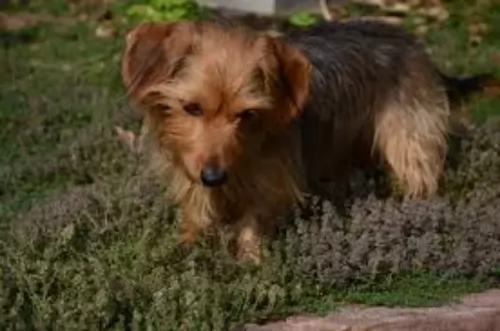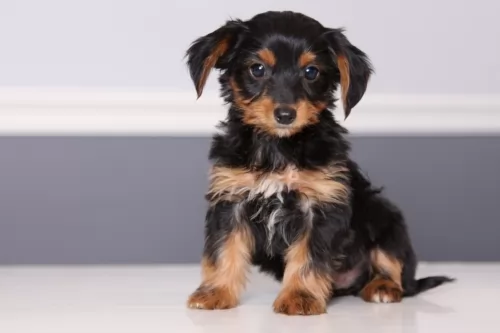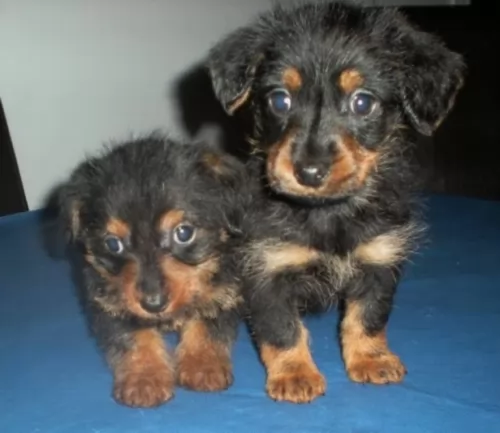 Petzlover
PetzloverDorkie is originated from United States but Toy Bulldog is originated from United Kingdom. Dorkie may grow 12 cm / 4 inches shorter than Toy Bulldog. Dorkie may weigh 12 kg / 26 pounds lesser than Toy Bulldog. Both Dorkie and Toy Bulldog has same life span. Both Dorkie and Toy Bulldog has almost same litter size. Both Dorkie and Toy Bulldog requires Low Maintenance.
 Dorkie Terriers originate from the United States of America. The small Dorkie, a cross between the Dachshund and the Yorkshire Terrier has a short history, unlike the two dog breeds that were bred to bring him about.
Dorkie Terriers originate from the United States of America. The small Dorkie, a cross between the Dachshund and the Yorkshire Terrier has a short history, unlike the two dog breeds that were bred to bring him about.
These dog breeds were both used for hunting small animals but the Dorkie today is essentially a companion dog. The International Designer Canine Association started recording registration of the Dorkie from 2009.
It is believed that the reason for this is that there were different breeding groups working in different directions. One of the groups wanted a smaller dog and there was also an attempt to cross French Bulldogs with Bulldogs to decrease their weight, but this breed was also not developed.
 The Dorkie is a small hybrid breed standing at 13 – 23cm in height and weighing 2 – 6kg. The Dorkie mostly comes with long, straight hair but there are however Dorkies who have the short hair of the Dachshund.
The Dorkie is a small hybrid breed standing at 13 – 23cm in height and weighing 2 – 6kg. The Dorkie mostly comes with long, straight hair but there are however Dorkies who have the short hair of the Dachshund.
The Dorkie is hypoallergenic, making them the ideal pet for allergy sufferers. They have floppy ears, a long body and short legs. The tail is long and furry. Most times they come in the Yorkshire Terrier colors of black and tan, but this can also vary.
The Dorkie is a loving, loyal, happy little dog who makes an excellent family dog. Although he isn’t looked upon as your typical lap dog, it is what he is really, as he loves nothing more than to be curling up on your lap or as close to you as he can get.
He loves spending time with his human family and is a social, extrovert kind of dog. Because he is also alert, he will do a good job of alerting his family to danger. He is good with children, but because of his smallness, rough children will need to be careful in rough and tumble games as he could get injured.
Even with a small dog like this, he will need training and socialization otherwise he can become a yapper, which comes from the Dachshund side. Training makes him obedient and relaxed around visitors in the home, and because he is an intelligent breed, he is easy to train and is a great dog for first time dog owners.
The Toy Bulldog was a medium sized dog standing at between 25 to 35cm in height and weighing between 11 and 18kg.
The coat of the dog was short and smooth and came in colors such as white and fawn, red or brindle. He had quite a bit of soft skin around the face and neck.
He was a small dog with a large body, short legs, broad muzzle, small ears and a docked tail.
The coat was glossy and short and they had soft skin and hair around the neck and head. They come in a variety of different colors ranging from pale yellow, light fawn to solid red.
The Toy Bulldog was a loyal and affectionate dog towards his human family It’s a pity he became extinct because he was amusing and entertaining, a great friend and companion.
They were calm dogs and didn’t require a lot of space and would have adapted well to life in the city or the countryside.
 Dorkies are easy going little dogs and adapt easily to life in the city or in the country.
Dorkies are easy going little dogs and adapt easily to life in the city or in the country.
Ideally they are inside dogs, feeling happy and content around their human family. They love adults and children and will get on well with other pets in the home too.
They are quite active little dogs and will thrive on games inside the home or outside in the garden. He may be small, but you can put him on a leash and take him for walks.
They make excellent pets and are only too happy to become a devoted and loyal family member of yours.
The Toy Bulldog was friendly, docile, calm and gentle although tending to be a little bit stubborn.
He no doubt made a wonderful pet and would have been ideal for single people, families as well as older people. He would have made a splendid pet, and would have been an indoor kind of pet.
Not particularly high in energy, he would have enjoyed some exercise just to ensure he didn’t put on weight. He’s extinct now, but there are other popular bull dog breeds, and something of him lives on in these modern bulldogs.
 The Dorkie, being a cross-breed, is a healthy dog and with good care can live t be 10 – 13 years of age. Nonetheless he is still prone to genetic problems and he can inherit traits from both parents.
The Dorkie, being a cross-breed, is a healthy dog and with good care can live t be 10 – 13 years of age. Nonetheless he is still prone to genetic problems and he can inherit traits from both parents.
A healthy diet will be needed to maintain the Dorkie’s health. You don’t want to overfeed your Dorkie, more so because he is a small dog.
The way you feed a dog can have a massive impact on his health and longevity. Just remember that a dog that is obese will battle to exercise, but also obesity can result in serious health problems, putting strain on the bones and joints too.
You don’t want to feed your dog day after day with kibble, and adding in some cooked rice, vegetables and chicken can just give him a more varied diet. Raw meat can also be included from time to time. Always ensure that there is fresh, cool water available to him.
The most common symptoms of an allergy is skin irritation – your pet will be constantly scratching and licking. Some skin conditions with your Dorkie can be cleared up quickly while some might be so severe as to require lifelong treatment.
It is believed that that these dogs were healthy in their day but were no doubt prone to some canine illness issues just like any other dogs.
They would likely have battled with eye issues such as cherry eye, as well as joint problems.
Cherry eye in dogs may not mean your dog’s life is in danger, but left untreated it can cause bigger eye problems later on.
Unlike a human being, a dog has 3 eyelids, with the 3rd one giving added protection to the dog’s eyes. It’s job is to keep dirt from entering the eyes.
There is a gland in the 3rd eyelid which can move out of place and then it bulges. This is what cherry eye is. The eye becomes irritated and the gland produces discharge. It is best to get your dog to the vet who has the skills and know-how to push the gland back into place.
 What you feed your pet can play an important role in managing health and skin conditions. Speak to your vet about special quality dog foods that can help reduce skin conditions and other nasty reactions to common, unhealthy food ingredients.
What you feed your pet can play an important role in managing health and skin conditions. Speak to your vet about special quality dog foods that can help reduce skin conditions and other nasty reactions to common, unhealthy food ingredients.
Dorkies are very low maintenance dogs, and they will require a brushing every 2 weeks. Those with longer coats may require some professional grooming. Check their teeth regularly and brush them 2 or 3 times a week. The occasional nail clipping may also be required.
The Toy Bulldog would have needed healthy, quality food to remain healthy. It is believed he became extinct in the early 1900s. Maybe there weren't commercially manufactured dog foods then. Their owners possibly tossed them scraps from the table.
Any dog would have to receive a good quota of vitamins and minerals in their food to stay healthy. If the dog was around today, you would read on the packaging label to see what to give him and definitely include some tasty home-made food too.
Nothing spicy and exotic – just plain, boiled chicken, brown rice, sweet potatoes and spinach. Simple foods like this ensure a dog remains free of stomach ailments.
The Toy Bulldog with his short coat would have been easy to groom. He would have required a brush twice a week.
You had to be careful with a dog like this. He didn’t tolerate the heat well. He was not suited for running or jogging and could have developed heat stroke and weakness with his excessive panting. All the huffing and puffing and sweating would have irritated his skin as well.
He would have needed a warm, dry place to sleep indoors. If he went outside, he would have required shade and sunshine to lie in.